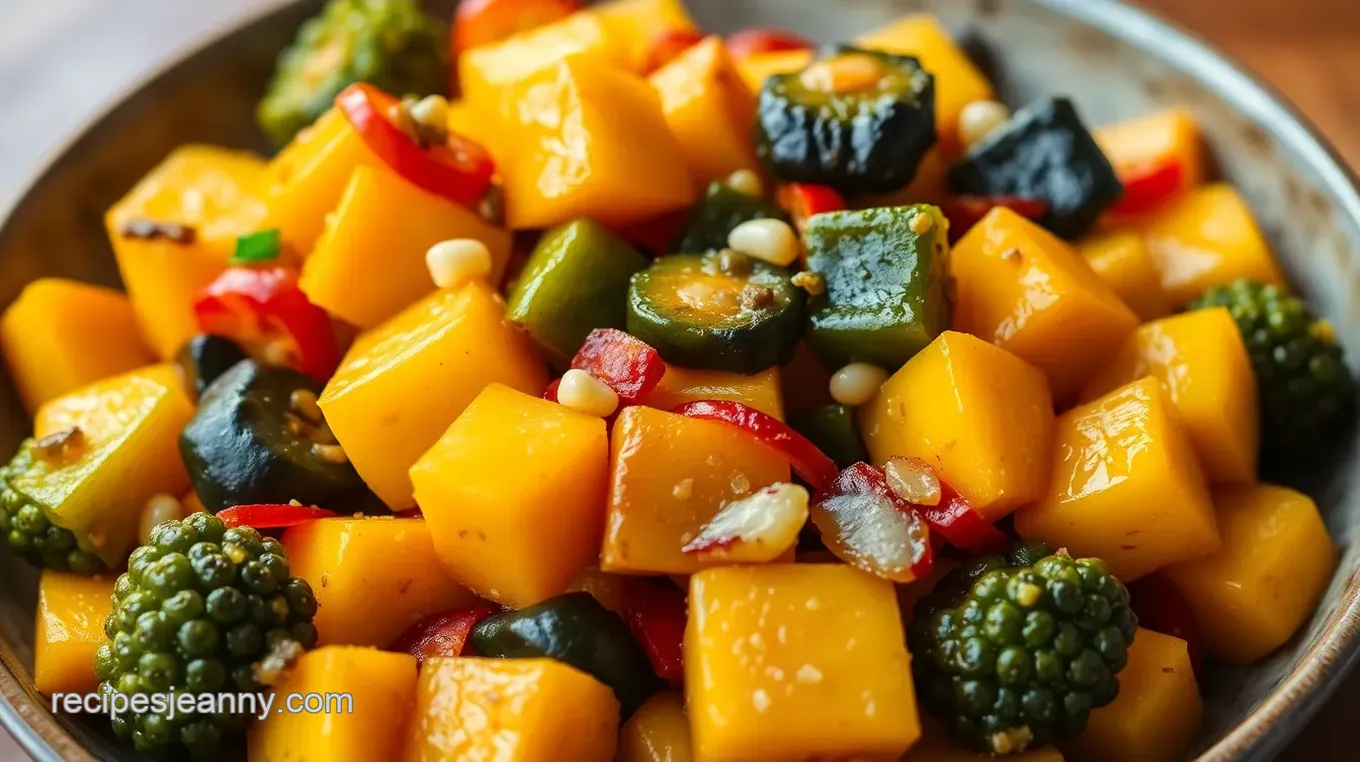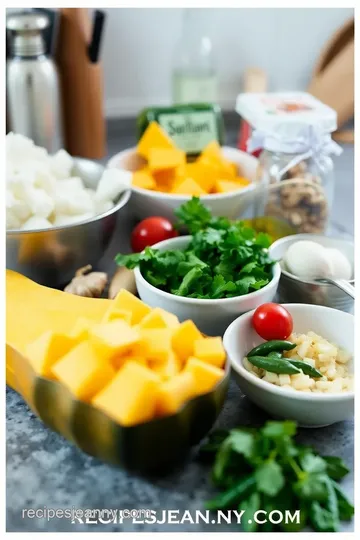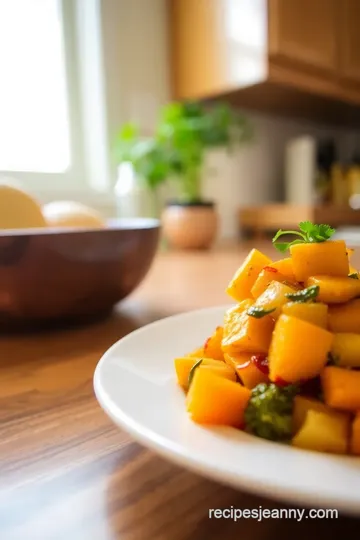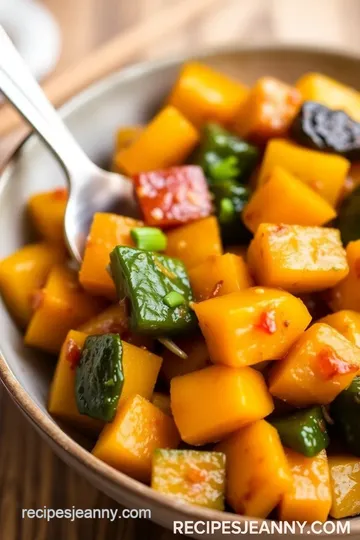Vegan Kabocha Squash Stir-Fry
Vegan Kabocha Squash Stir-Fry ready in 35 minutes! Sauté delicious kabocha with garlic, ginger, and veggies for a healthy vegan meal. Perfect for any occasion.

- about introduction
- the complete guide to authentic vegan kabocha squash stir - fry
- why you'll love this version
- health & nutrition highlights
- recipe at a glance
- essential components guide
- kitchen equipment essentials
- pro ingredient tips
- professional cooking guide
- professional secrets
- perfect presentation
- storage & make - ahead
- creative variations
- expert faq solutions
- complete nutrition guide
- Recipe Card
about introduction
the vegan kabocha squash stir - fry is not just a delightful dish; it’s a celebration of flavors that has deep roots in asian culinary traditions, kabocha squash, also known as japanese pumpkin, has been cherished for centuries in japan and other parts of asia, its...
what sets this vegan kabocha squash stir - fry apart is its ability to bring together an array of vegetables, packed with nutrients, into one harmonious dish, it’s not only easy to prepare but also incredibly versatile. whether you’re a seasoned chef or just starting your culinary journey, this recipe offers an inviting taste of healthy eating without sacrificing flavor .
the complete guide to authentic vegan kabocha squash stir - fry
this dish draws from a rich culinary heritage rooted in asian cuisine, using kabocha squash provides depth and richness that few other vegetables can match, originating from central america before being introduced to asia by spanish explorers, kabocha squash became widely appreciated for its deliciousness and nutritional benefits .
culturally significant in many regions, especially during harvest festivals in japan or family gatherings across asia, kabocha symbolizes abundance and health, in modern - day kitchens around the globe, particularly among those who embrace plant - based diets or are looking for lighter fare without compromising on taste the popularity of kabocha continues to soar.
why you'll love this version
you’ll fall head over heels for the unique flavor combinations found here savory garlic mingling with zesty ginger creates an aromatic base that dances on your palate. plus, we’ve incorporated foolproof techniques so even if you’re new at cooking veggies like kabocha or snap peas you can whip up something spectacular every time.
our expert - tested method guarantees success while keeping prep work simple enough not to overwhelm novice cooks; after all this should be fun. and let’s face it : life gets busy sometimes. that’s why i’ve included some killer time - saving tips throughout the recipe so you can savor every bite without feeling rushed .
health & nutrition highlights
let’s chat about nutrition because this stir - fry isn't just delicious it packs quite the punch when it comes to health benefits too. kabocha squash is loaded with vitamins a and c along with dietary fiber which supports digestion while promoting glowing skin definitely something we all want.
moreover, since it's naturally low - calorie yet filling thanks to its fiber content it perfectly fits various dietary considerations including veganism or gluten - free lifestyles. whipping up meals like this helps maintain balanced nutrition without complicated ingredients; talk about wellness advantages.
in terms of balanced nutrition facts per serving : you're looking at roughly 180 calories alongside essential nutrients making each bite guilt - free goodness that's good for you.
recipe at a glance
here’s what you need to know before diving into making your own vegan kabocha squash stir - fry :
- total preparation time : just 15 minutes .
- skill level required : easy peasy.
- serving size details : serves four generous portions .
- cost efficiency : affordable ingredients mean great value.
with such straightforward steps involved combined with nutrient - rich components this recipe will become an instant favorite whether shared at dinner parties or enjoyed solo after long days filled with hustle & bustle .
by embracing this easy chinese squash recipes kabocha vegan delight you'll satisfy cravings while nourishing both body and soul effortlessly.

essential components guide
premium core ingredients
when it comes to making a delicious vegan kabocha squash stir - fry, quality ingredients make all the difference. here’s your go - to guide for selecting the best core components .
-
kabocha squash : aim for one medium kabocha squash, about 2 - 3 pounds, look for a firm exterior with no soft spots or blemishes this indicates freshness, when you cut into it, the flesh should be bright orange and slightly sweet - smelling, store any leftover pieces wrapped tightly in plastic wrap in the fridge for up to a week .
-
vegetable oil : you’ll need 2 tablespoons of vegetable oil (or any neutral oil), choose oils like canola or grapeseed that have high smoke points; they’re perfect for stir - frying, keep your oils in a cool, dark place to extend their shelf life .
-
garlic & ginger : use three cloves of fresh garlic and one - inch piece of ginger, both minced, fresh is key here. look for firm garlic bulbs without sprouting shoots and ginger roots that are smooth and free from wrinkles, stored properly in a cool pantry, they will last several weeks .
-
fresh vegetables : the red bell pepper should be vibrant with no wrinkles or dark spots opt for one medium - sized pepper sliced thinly, for snap peas or green beans (you can choose either), look for bright green pods that snap easily when bent; this means they're fresh. carrots should be crisp and firm; julienne them or slice thinly as per your preference .
with these premium core ingredients prepped and ready to go, you're well on your way to crafting an amazing stir - fry.
signature seasoning blend
no dish is complete without its signature seasoning blend. this vegan kabocha stir - fry gets its delightful flavor profile from some simple yet impactful seasonings .
-
soy sauce : you'll use 2 tablespoons of soy sauce (or tamari if you're going gluten - free), opt for low - sodium versions if you prefer less saltiness while still enjoying that umami kick.
-
hoisin sauce : just 1 tablespoon adds depth and sweetness look out for brands with natural ingredients listed first on the label .
-
sesame oil : a finishing touch of 1 tablespoon toasted sesame oil brings nutty warmth to this dish, it's potent stuff; just remember it goes a long way.
to enhance those flavors even more, consider adding in some crushed red pepper flakes if you’re feeling spicy.
smart substitutions
sometimes life doesn’t give you all the right ingredients at once and that's totally okay. here are some smart substitutions :
-
if kabocha squash isn't available ? no worries. butternut squash works wonderfully as an alternative .
-
for those avoiding soy products altogether, coconut aminos can replace soy sauce nicely while offering similar depth of flavor .
-
want extra protein ? toss in cubed tofu at step #3 instead of stirring only veggies it makes everything heartier.
seasonal variations also come into play here feel free to swap out those veggies based on what’s fresh at your local farmer's market.
kitchen equipment essentials
cooking up this stir - fry doesn’t require fancy gadgets but there are definitely must - haves you'll want handy :
must - have tools
a good sharp knife will make peeling and chopping so much easier you don’t want dull blades slowing down dinner prep. pair it with a sturdy cutting board (wooden ones are great.)
recommended appliances
investing in a large skillet or wok is essential since they distribute heat evenly across all those yummy veggies during cooking time plus they're spacious enough not to overcrowd them .
helpful gadgets
grab yourself a vegetable peeler if you don't have one it saves time when prepping kabocha squash, a microplane zester is also fantastic when grating ginger finely so it's incorporated seamlessly into dishes .
home alternatives
if you're lacking certain tools like woks ? no problem a big frying pan works just fine too.
pro ingredient tips
finally, let’s get down to some pro tips that'll keep your kitchen game strong :
1, when selecting kabocha squash or any veggie really always check color vibrancy and firmness first the fresher looking produce usually tastes better.
1, make sure any oils used appear clear rather than cloudy which could indicate spoilage .
1, storing chopped vegetables correctly helps prevent waste; keep them sealed tight in containers lined with paper towels they absorb moisture preventing sogginess .
1, buy spices from bulk sections whenever possible not only do you save money but often get fresher options too.
now armed with this essential ingredient guide tailored towards creating easy chinese squash recipes kabocha vegan style you'll feel confident diving right into whipping up an impressive meal anyone would enjoy sharing around their dinner table. bon appétit.
professional cooking guide
cooking like a pro involves careful preparation, precise techniques, and an organized approach, whether you’re whipping up a weeknight dinner or preparing for a special occasion, these tips will help ensure your culinary success .
essential preparation steps
mise en place details
start by gathering all your ingredients before you begin cooking, this means washing, chopping, and measuring everything out in advance, for example, if you're making a stir - fry, have your vegetables sliced and ready to go, this not only saves time but also prevents last - minute scrambling trust me; it's much easier.
prep techniques
learn basic cutting skills : julienne carrots into thin strips or dice onions evenly, use the right tools; a sharp knife makes all the difference. if you’re prepping ahead of time (which i totally recommend), store prepped items in labeled containers to avoid confusion later on .
time management
estimate how long each step will take and adjust accordingly, if something requires longer cooking (like roasting veggies), start that first while prepping other ingredients simultaneously .
organization tips
keep your workspace tidy as you go along clean as you cook. it’ll make the whole process smoother and more enjoyable, plus, it’s always satisfying to work in an organized kitchen .
professional cooking method
step - by - step process
follow recipes closely at first until you're comfortable improvising with flavors or techniques, for instance, when sautéing vegetables for a stir - fry, heat oil in the pan over medium - high until it shimmers before adding garlic to prevent burning .
temperature control understanding temperature is critical. for sautéing, aim for around 375°f (190°c), a hot pan ensures quick browning without steaming food a common mistake many beginners make.
timing precision timing is key; undercooked food can be just as disappointing as overcooked. set timers for different components so nothing gets left behind especially those delicate ingredients like green beans that should remain crisp yet tender .
success indicators
as you're cooking :
- color : look for vibrant colors as veggies cook .
- texture : vegetables should be tender - crisp not mushy.
- aroma : the smell of browning garlic or sizzling spices is usually a good sign things are going well.
expert techniques
professional methods
don’t shy away from using professional - grade methods like blanching vegetables briefly before finishing them off in the main dish it helps lock in color and nutrients while maintaining crunchiness.
critical steps
always taste throughout cooking. adjust seasonings gradually rather than dumping everything at once you want balanced flavors that shine through without overpowering one another .
precision points
pay attention when working with proteins; they often require specific internal temperatures for safe consumption (165°f/75°c for poultry) .
quality checks
before serving any dish, check textures again everything should feel right before plating up.
success strategies
troubleshooting tips
if something doesn’t taste quite right halfway through ? don’t panic. add acid (like lemon juice) or sweetness (a pinch of sugar) to balance flavors instead of starting from scratch .
quality assurance
invest time into tasting sauces/soups during preparation stages they should evolve into harmonious blends by adjusting seasoning carefully along the way .
perfect results guide
for baked goods : invest in an oven thermometer to assure correct baking temps since ovens can vary widely even slight differences affect outcomes significantly.
final touches
garnish dishes thoughtfully with herbs or nuts right before serving it adds visual appeal plus freshness that elevates any meal instantly.
remember : practice makes perfect and don’t forget to enjoy yourself during this delicious journey of learning new skills. happy cooking.

professional secrets
when it comes to crafting the perfect vegan kabocha squash stir - fry, a few professional insights can take your dish from good to fabulous, first off, always select a kabocha squash that feels heavy for its size this usually means it’s ripe and full of flavor, and here’s an expert technique : marinating your squash cubes in soy sauce for about an hour before cooking infuses them with deeper flavors .
kitchen wisdom also suggests using high heat when stir - frying; this helps achieve that coveted crispy texture while keeping the veggies vibrant and fresh, if you're feeling adventurous, try adding a splash of rice vinegar or lime juice at the end for a zesty kick. these small tweaks often guarantee success .
perfect presentation
let’s talk about making your stir - fry not just tasty but pretty too, plating techniques can really elevate your dish, for instance, arrange the vegetables in a colorful spiral on one side of your plate, leaving room for fluffy jasmine rice on the other .
garnish ideas include chopped green onions and toasted sesame seeds they add crunch and vibrancy. serving suggestions ? you could even scoop some into lettuce wraps for fun finger food or serve it over quinoa if you’re looking to mix things up .
visual appeal tips are simple : use contrasting colors and shapes when plating to make each component pop.
storage & make - ahead
so you’ve made extra vegan kabocha squash stir - fry now what ? proper storage guidelines play a big role here. let it cool completely before transferring it to an airtight container; it'll keep well in the fridge for up to 3 - 4 days .
for preservation methods, consider freezing portions if you want leftovers down the line (just be sure to leave out any garnishes), reheating instructions are straightforward : toss it back in a pan over medium heat until warmed through or microwave in short intervals until hot .
to maintain freshness tips, store raw kabocha squash whole in a cool space like your pantry it lasts longer that way.
creative variations
feeling creative ? there are endless flavor adaptations you can try with this recipe. swap out snap peas for asparagus during springtime or throw some broccoli florets into mix they both work wonders with kabocha’s sweetness .
dietary modifications can easily cater to different preferences : use tamari instead of soy sauce for gluten - free needs or replace hoisin with coconut aminos if avoiding sugar is key, seasonal twists might include tossing in roasted sweet potatoes come fall.
regional variations could involve adding spices like curry powder a nod towards indian cuisine or even incorporating thai basil as an aromatic twist.
expert faq solutions
wondering how long should i cook my veggies ? the general rule is around 5 - 7 minutes; they should be tender yet crisp. common concerns also revolve around oil usage feel free to adjust based on dietary needs; less oil still yields delicious results .
expert answers often clarify whether it's okay to use pre - cut produce absolutely. just remember they may cook faster than whole pieces so keep an eye on them, a troubleshooting guide would point out if things seem soggy; turn up that heat next time and give those veggies space while cooking.
success tips include prepping all ingredients beforehand you’ll feel like a pro chef ready for action.
complete nutrition guide
alright, let’s break down what makes this dish not just tasty but also healthy. each serving provides approximately 180 calories along with fiber benefits from both kabocha squash and veggies included talk about filling without guilt.
health benefits abound as kabocha is rich in vitamins a and c while being low - calorie too a win - win situation if you ask me. dietary information highlights four grams of protein per serving which isn’t bad considering it's plant - based goodness .
portion guidance suggests sticking with one - fourth of your plate filled with stir - fried goodness complemented by grains that way you're getting balanced nutrition without overdoing anything.

Vegan Kabocha Squash Stir-Fry Card

⚖️ Ingredients:
- 1 medium kabocha squash (about 2-3 pounds), peeled, seeded, and cut into cubes
- 2 tablespoons vegetable oil (or any neutral oil)
- 3 cloves garlic, minced
- 1-inch piece ginger, minced or grated
- 1 red bell pepper, sliced
- 1 cup snap peas or green beans, trimmed
- ½ cup carrots, julienned or sliced thinly
- 2 tablespoons soy sauce (or tamari for gluten-free)
- 1 tablespoon hoisin sauce
- 1 tablespoon sesame oil
- Salt and pepper to taste
🥄 Instructions:
- Step 1: Prepare the Kabocha Squash: Start by peeling the kabocha squash using a sharp vegetable peeler. Cut it in half and scoop out the seeds with a spoon. Then, chop it into bite-sized cubes.
- Step 2: Heat Oil in Pan: In a large skillet or wok, heat 2 tablespoons of vegetable oil over medium-high heat until shimmering.
- Step 3: Sauté Aromatics: Add the minced garlic and ginger to the hot oil and sauté for about 30 seconds until fragrant but not browned.
- Step 4: Cook Vegetables: Add the cubed kabocha squash to the pan and stir-fry for about 5–7 minutes until it starts to soften. Next, add in sliced red bell pepper, snap peas (or green beans), and carrots. Continue stir-frying for another 5–7 minutes until all vegetables are tender but still crisp.
- Step 5: Add Sauces: Pour in soy sauce, hoisin sauce, and sesame oil; toss everything together so that the vegetables are evenly coated with the sauces.
- Step 6: Seasoning: Season with salt and pepper as needed; stir well to combine all flavors.
- Step 7: Serve: Once everything is heated through nicely (about another minute), remove from heat. Transfer your vegan kabocha stir-fry onto serving plates or bowls.
- Step 8: Garnish: If desired, sprinkle chopped green onions and toasted sesame seeds on top before serving.
Previous Recipe: Bake Gaps Raisin Muffins - Quick & Delicious
Next Recipe: Chill Dino Jello Cups with Tasty Gummies
